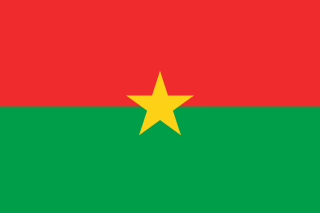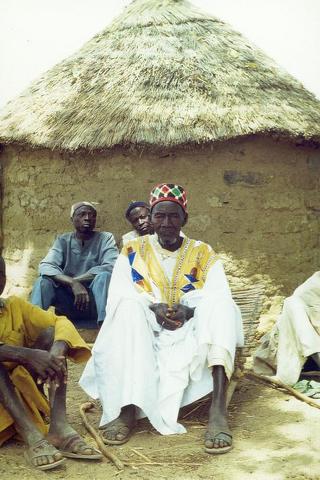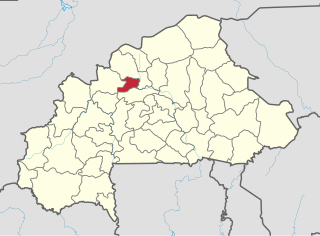
Burkina Faso is a landlocked country in West Africa with an area of 274,200 km2 (105,900 sq mi), bordered by Mali to the northwest, Niger to the northeast, Benin to the southeast, Togo and Ghana to the south, and the Ivory Coast to the southwest. As of 2021, the country had an estimated population of 20,321,378. Previously called Republic of Upper Volta (1958–1984), it was renamed Burkina Faso by President Thomas Sankara. Its citizens are known as Burkinabès, and its capital and largest city is Ouagadougou. Its name is often translated into English as the "Land of Honest Men".

Ouagadougou is the capital of Burkina Faso and the administrative, communications, cultural, and economic centre of the nation. It is also the country's largest city, with a population of 2,415,266 in 2019. The city's name is often shortened to Ouaga. The inhabitants are called ouagalais. The spelling of the name Ouagadougou is derived from the French orthography common in former French African colonies.

The music of Burkina Faso includes the folk music of 60 different ethnic groups. The Mossi people, centrally located around the capital, Ouagadougou, account for 40% of the population while, to the south, Gurunsi, Gurma, Dagaaba and Lobi populations, speaking Gur languages closely related to the Mossi language, extend into the coastal states. In the north and east the Fulani of the Sahel preponderate, while in the south and west the Mande languages are common; Samo, Bissa, Bobo, Senufo and Marka. Burkinabé traditional music has continued to thrive and musical output remains quite diverse. Popular music is mostly in French: Burkina Faso has yet to produce a major pan-African success.

The regions of Burkina Faso are divided into 45 administrative provinces. These 45 provinces are currently sub-divided into 351 departments or communes.

The Mossi are a Gur ethnic group native to modern Burkina Faso, primarily the Volta River basin. The Mossi are the largest ethnic group in Burkina Faso, constituting 52% of the population, or about 11.1 million people. The other 48% of Burkina Faso's population is composed of more than 60 ethnic groups, mainly the Gurunsi, Senufo, Lobi, Bobo and Fulani. The Mossi speak the Mòoré language.

Koudougou is a city in Burkina Faso's Boulkiemdé Province. It is located 75 kilometres (47 mi) west of Ouagadougou, the capital of Burkina Faso. With a population of 160,239 (2019) it is the third most populous city in Burkina Faso after Ouagadougou and Bobo Dioulasso and is mainly inhabited by the Gurunsi and Mossi ethnic groups. Koudougou is situated on the only railway line in Burkina Faso and has some small industries, a market, a university and provincial government offices.

Gaoua is a market town in southern Burkina Faso known for its superstitious values and customs. The population, rested at 45,284. Located in the red earth, green hills, and fast flowing streams of southwestern Burkina Faso, Gaoua is the capital of Poni Province and forms a sort of capital for the sacred rites and bush lore of the Lobi peoples. According to local myth, Gaoua was founded when the Lobi migrated across from northern Ghana where they found the Gan people peoples occupying the territory. As a result, they named the trek across to Gaoua Gan-houo meaning "route of the Gan people".

Yatenga is one of the provinces of Burkina Faso, located in the Nord Region of the country. In modern Yatenga, the most prominent city is Ouahigouya. This city served as the capital of the kingdom of Yatenga, a powerful kingdom out of the many Mossi kingdoms, but its influence decreased in the century following French colonisation. The city is famed today for being home to the Naba's compound and the tomb of Naba Kango.

Zondoma is one of the 45 provinces of Burkina Faso, located in its Nord Region. In 2019 the population was 239,955. Its capital is Gourcy.

Zorgho is a town in 8the Zorgho Department of Ganzourgou Province in Burkina Faso. Zorgho is the capital of Zorgho Department and Ganzourgou Province and has a population of 35,398.
Articles related to Burkina Faso include:
The Gurunsi, or Grunshi, are a set of related ethnic groups inhabiting northern Ghana and south and central Burkina Faso.
Rollo is a small town of 7783 people and the capital of Rollo Department, Bam Province, Burkina Faso, West Africa. The Départment of Rollo has 25,000 adults, and in 2007, as part of national political decentralisation, Issa Ouermi was elected mayor of Rollo Department.

Zimtenga, also spelt Zimtanga, is a department or commune of Bam Province in Centre-Nord Region of Burkina Faso. Its capital lies at the town of Zimtenga. According to the 1996 census the department has a total population of 21,879.
Ibi, Burkina Faso is a village in Rollo Department of Bam Province in northern Burkina Faso, West Africa. It has a population of 1374, mostly Mossi peoples. It is accessed by a track from Rollo and is very remote, even by the standards of northern Burkina Faso. There are no vehicles in the village other than mopeds, carts and bicycles and traditional agriculture is the main occupation.
Tambella Mossi, also spelt Tambiella Mossi or Tambella-Mossi, is a commune in the Andemtenga Department of Kouritenga Province in the Centre-Est region of Burkina Faso. It had a population of 1,929 in 2006.
Namoukouka is a village in the Gounghin Department of Kouritenga Province in the Centre-Est region of Burkina Faso. It had a population of 810 in 2006.
Sanrgo is a rural settlement situated in Kaya department, Sanmatenga province, in the region of Centre-Nord in Burkina Faso.














